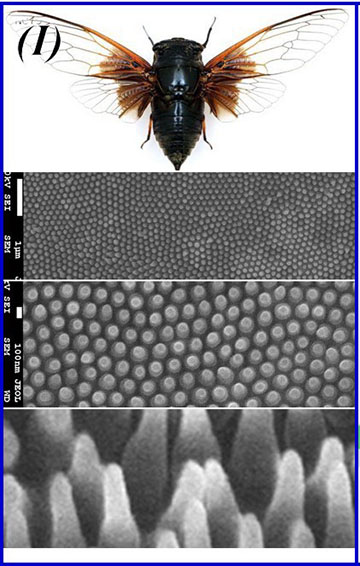
Photograph and scanning electron microscope characterizations of a cicada wing (Cryptympana atrata Fabricius).
Inspired by cicada wings, researchers from Shanghai Jiao Tong University, China, have demonstrated an antireflective patterned nanosurface that they say can suppress visible light at different angles of incidence (Appl. Phys. Lett., doi: 10.1063/1.4962903). The surface, made from titanium dioxide (TiO2) using a simple and low-cost sol-gel method, is covered with antireflective structures (ARSs) that could, according to the authors, be used to prevent sunlight—which enters a solar cell from many angles—from escaping, thus increasing the cell’s efficiency.
Subwavelength structures
ARSs have the potential to maximize solar cell performance, since the tiny structures can minimize the light reflected out of the cell, thereby increasing the amount of incident sunlight entering the absorber layer. The ARSs reduce the Fresnel reflection between the air and the solar cell surface by creating a change in optical impedance that matches the air-to-surface interface.
Cicada wings include such subwavelength structures, and other scientists have developed methods to replicate the nanoarrays on the wings. But the Shanghai Jiao Tong University team designed and tested a new, low-cost, simple and faster method of creating cicada patterns, by going directly to the source. Specifically, the researchers used a sol-gel technique, which involved coating the top surface of a cicada wing in TiO2, followed by calcination at 500 °C to burn off the organic wing template. After calcination, a homogenous coating of TiO2 forms with precisely patterned subwavelength ARSs. (TiO2 is commonly used in silicon solar cells because of its antireflective properties and high refractive index of 2.3. The highly stable semiconductor material also offers chemical and mechanical resistance.)
Testing the surface
To demonstrate the biomorphic surface’s angle-dependent antireflective properties, the scientists measured the return of incident light to the outside atmosphere with an angle-resolved spectrometer over a range of wavelengths in the visible spectrum (450 nm to 750 nm). Their demonstrations showed that the templated surface’s “reflectivity gradually changed from 1.4 percent to 7.8 percent as the angle of incidence changed from normal to 45 degrees.” The authors say that the small spaces between the ARSs create a sort of light transfer path that leads incident light rays into the interior of the nanopatterned surface. The light transfer path would theoretically help funnel sunlight into the absorbing layer of a solar cell.
Wang Zhang, associate professor and coauthor, says: “We expect our work to inspire and motivate engineers to develop antireflective surfaces with unique structures for various practical applications.”
